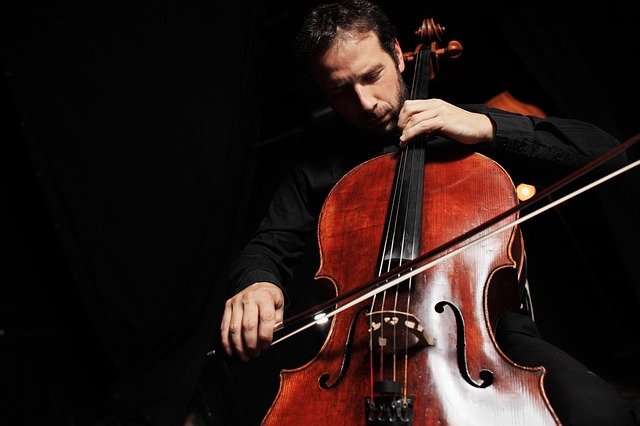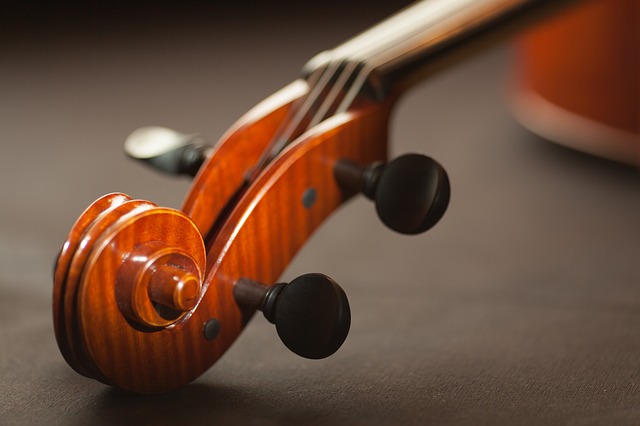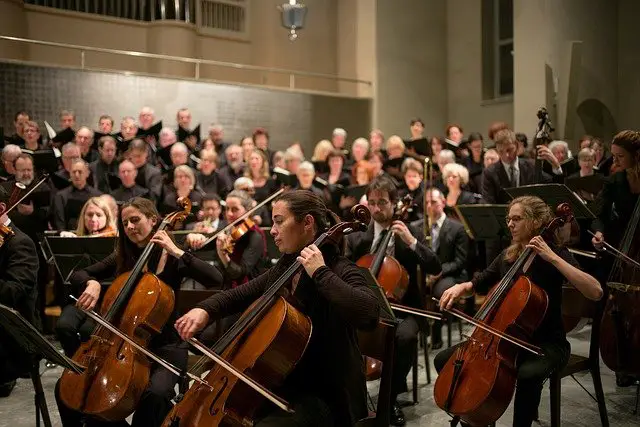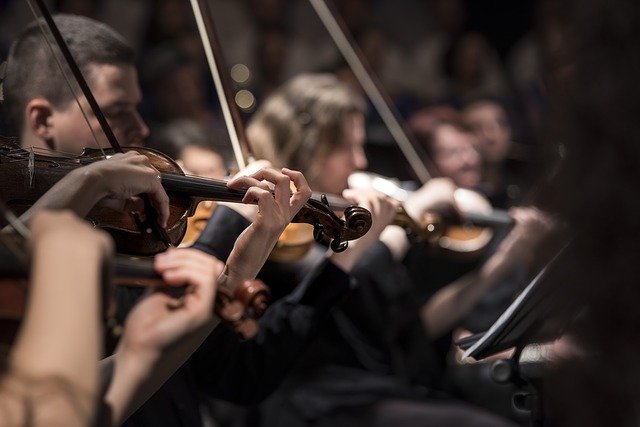
Cello vs Violin: What’s The Difference and Which is Best For YOU?
Wondering whether to pick up a stringed instrument? Intrigued by the cello vs violin and want to know which is for you? Struggling to choose between these two beautiful string instruments?
If you answered yes to any of those, this article is for you!
We compare and contrast two of the world’s most popular classical stringed instruments, the violin and the cello. While very different in terms of size, they are more alike than you might think in other ways.
Both instruments have a pivotal part to play within an orchestra and both have standout features and some pros and cons. This article will walk you through each of them.
You can buy traditional cellos and violins and electric variants. As most beginners will start with the traditional wood instrument, this article deals exclusively with those. We have other articles covering both the electric violin and electric cello.
Contents
Fundamental differences between violin and cello
Let’s begin with the basics. Here are some of the key differences between the violin and the cello.
Size
First let us cover the most obvious. Size. The cello can be up to three times the size of a violin and is played in a seated position. The cello is free-standing, using its own stand to support its weight while leaning against your knee and shoulder.
The violin comes in a range of sizes but the full size (4/4), is a standard size. Violins are relatively light and sit on your upper shoulder while being supported by your hand on the neck and chin on the chin rest.
Depending on your size or age, the size and weight of a cello may be too much. That makes the violin the string instrument for you. At least while you’re growing.
Position
There is an obvious difference in how the violin is held versus the cello. This can actually be a deciding factor in some people choosing one over the other as one position will be more comfortable than the other.
The violin requires a relatively upright position with the violin resting on your shoulder and your bow arm held at an angle. You will support the violin with your chin and with your other hand at the neck. This is a position you will either find completely comfortable, or not.
Given its size and weight, the cello rests on the floor. You will typically sit with it resting in your knee with the neck against your shoulder. You will still require an upright position but the arms are able to be more relaxed while being seated can be more comfortable for some over longer periods.
There is no ‘best’ here. Some musicians find the violin to be very comfortable to play for many hours at a time. Others have difficulty with the position and will find the cello more comfortable.
We would advise trying both to see if you naturally prefer one position over the other.
Range
Another key difference between violin and cello is the note range.
The violin is the equivalent of soprano with a high range thanks to the G, D, A, and E strings. The full range for a violin is down to G3 and up to A7. Due to this range, violins are often seen solo or playing key pieces of a composition.
The cello has a much lower range and is strung with A, D, G, C strings allowing it to deliver both alto and soprano notes. The cello is most often used to provide harmony and rhythm in an orchestra. There are compositions with cello solos, although they are rare.
Each of us has a different ear that responds to different sounds. Some will find the higher notes of the violin work best while others will prefer the lower tones of the cello. Again, try both and see which resonates best with your personal tastes.
Practicality
While linked to size, the practicality of an instrument will influence how much you practice. If the instrument doesn’t work for you in terms of portability, you’re not likely to actively want to take it to practice!
The violin is smaller and lighter and will fit into a case you can carry in one hand. Hard cases are recommended to keep the violin in good condition but these are still light enough to carry.
The cello is larger and heavier. As it is made of wood and uses strings, it too will need a hard case to protect it. While size may be an issue, most cello cases have handles and even wheels to help transport it. You will need a larger car or means of transport though.
Cost
Nobody picks up a particular string instrument over another purely for the cost but it is something to factor in.
There is no doubt that cello can be much more expensive than a violin to buy. A beginner violin outfit could cost as little as $50 but you’re going to need close to $500 for a beginner cello outfit. That rises exponentially as you climb the skill levels.
If cost is a factor, this may be the one choice that is out of your control. There is a thriving used instrument market though. If you cannot afford a new cello, you could always source a used one.
Versatility
One thing not many new musicians tend to consider is the versatility of each instrument. This can have a huge influence over how much you enjoy them.
Those who play the violin will tell you that this is primarily a classical instrument.
But you also have modern, jazz, gospel, country, Bluegrass, rock and other musical styles with space for a violin. This can offer much-needed variety to your repertoire and could be a significant advantage if you’re not purely into classical music.
The cello is more limited with fewer opportunities to experiment with genres. There are pieces in other genres for cello but you may have to search much harder to find them.
Materials used
The violin and the cello look similar but there are differences in how they are constructed.
The cello is made using a spruce top with maple for the back, sides and neck. Poplar and willow can also be used for the back and sides. Beginner cellos can often be made using cheaper laminates.
The violin is traditionally made using maple for the sides and back while spruce is used for the top. The neck, fingerboard and pegs are often made of ebony because of the colour and density.
While these differences are minor, they are enough to create a completely different sound and feel to each instrument.
Differences in strings and bows
Aside from size, there are also differences in how the cello bow and violin bow are put together.
The cello bow is constructed using pernambuco or brazilwood. Traditional strings are no longer made from catgut but from composite materials. They are longer and fatter than violin strings.
The violin bow is also made from pernambuco or brazilwood but carbon fibre is becoming increasingly common. The strings are made of similar synthetic materials as cello strings while catgut is still used in high end violins.
Role in the orchestra
We have touched upon these instruments’ position in the orchestra but let’s expand on that now.
The cello is a support instrument most often used to provide harmony and melody within an orchestra. While there are solo pieces available, they are few and far between.
The violin plays a different role. The first violin will play solos and will have a more prominent role providing melody to the composition. The second violin will have more of a support role and while still providing melody, will not have solos.
This video gives a useful overview of both the violin and the cello:
Other things you might want to know about the violin and cello
Those fundamental differences mentioned above may be enough to sway your decision one way or the other. There are a couple of other things you might want to know about the cello and violin.
Which is older, the violin or cello?
When we started playing, it was widely thought the violin was the older instrument. New discoveries actually found that the cello is older by a significant margin.
The Italian Andrea Amati, is credited with building the first cello back in 1538 for the famous Medici family. Katharine de Medici apparently wanted a new instrument to impress society so employed Amati to build her a cello.
The same artist, Andrea Amati is also credited with building the first violin in 1560.
Another Italian, Gaudenzio Ferrari is credited with painting something similar to a violin in the 1530s but it only had three strings. We don’t know who built it but it is the first record of a violin-type instrument we know of.
The double bass
The double bass is larger than the cello and is most often played standing up. If you find neither the cello or violin work for you, the double bass might.
As the name implies, the double bass has a much lower note range than either the cello or violin. It is most often used for providing rhythm and can be used with a bow or plucked.
The double bass is almost as versatile as the violin, being used in jazz, country, blues and other genres to great effect.
As the ear is naturally tuned to bass, there is always a place for double bass in an orchestra or live band. That makes it worth considering if you’re not feeling the violin or cello.
PROs and CONs of the Cello
Sometimes comparing a list of pros and cons of your choices can help you make your mind up. While there are dozens of pros and cons for both the violin and cello, these are what we think matter most.
The cello is a very popular instrument for a number of reasons but it isn’t without its drawbacks.
PROs
- Low note range will appeal to some musicians
- Ideal for musicians who don’t want to solo or stand out
- Easier to learn than violin
- Not quite as much competition to secure a place in an orchestra
- Seated position is more comfortable for some
CONs
- Size and weight make it more difficult to transport
- Bulky instrument that requires a shoulder and knee for support
- Cost can be a determining factor
- Not so many opportunities to stand out in an orchestra
PROs and CONs of the Violin
Just like the cello, the violin has pros and cons which could sway your decision to pick up this most famous stringed instrument.
PROs
- Small violins are lighter and easier to hold than the cello
- Often cheaper for beginners than the cello
- Higher range and tone that will suit some ears
- Similarity to the human voice range clinches it for some
- Huge selection of violins from the cheap to the extortionate
CONs
- The violin is widely regarded as harder to learn and to master
- Not ideal for musicians who don’t want to stand out in an orchestra
- Much more competition for places in orchestras
- Even more competition for first section
Which instrument is right for you?
Which instrument is right for you depends on your tastes, personality and ambition. As you can see, both instruments have different places within an orchestra, they sound and play differently and will have different styles.
While there is no overall ‘best’, there may be a best instrument for you.
If you’re considering picking up the violin or cello, bear these points in mind:
- Are there adequate teachers in your area for the violin or cello?
- Are there orchestras that feature either or require new musicians for one over the other?
- Does one instrument feel better when you hold it?
- Does the range and tone of one or the other appeal to your ear more?
- Would you be able to easily transport a cello?
The most important piece of advice we can offer is to spend time with both instruments. Book an hour with a teacher or in a music studio, play, hold and experience each instrument as much as you possibly can.
Close your eyes when you play or when the teacher plays and consider which range your ear is most tuned to. You’re going to be spending many hundreds, or thousands of hours with the instrument so you have to love it!
Cello vs violin FAQs
Is it harder to play cello or violin?
The violin is widely regarded as harder to play than the cello. That’s partly due to the more natural position with the cello and the more challenging pieces available for the violin.
What is the difference between a cello and a violin?
This article is dedicated to outlining the differences between a cello and a violin. Key differences include size, weight, position, practicality, versatility, cost, and range. There are other minor differences but these would make the most difference to beginners.
Can violinists play the cello?
Violinists can learn to play cello and vice versa. If you read this article in its entirety, you will see that you can learn both instruments but will likely naturally gravitate to one or the other. That’s not to say you cannot change your mind later and switch if you want to though.
Is cello louder than the violin?
A cello is not louder than a violin. Both use strings and harmonics to deliver sound so the actual decibel value will be similar. A violin may sound louder thanks to its higher range. Higher notes seem to travel further and faster than lower notes so you may perceive the violin to be louder even if it isn’t.
How long does it take to get good at the cello?
The time it takes to get good at the cello is directly influenced by the amount of time you practice. The more you practice, the better you’ll get. This does not account for natural talent but even virtuosos practice constantly.
Which is best – Violin or cello?
There are some distinct differences between the violin and the cello. These differences can be enough to turn you to one instrument or the other. Whichever way you turn and whichever instrument you decide to learn, one is not ‘better’ than the other.
Both instruments have a long and illustrious history. Both play very different roles within an orchestra and both have quite different play styles.
As we have said throughout this article, the best way to decide which instrument is best for you is to try them both. Not try as in standing in a music shop for ten minutes, but find a music teacher who works with both and spend an hour or so with each instrument.
If you’re going to be investing time and money into an instrument, you may as well invest it from the very beginning!
Remember, if the violin or cello doesn’t work for you, there’s always the viola or double bass!








+ There are no comments
Add yours